Quick Links: Insect Pest Control Services | Home Services | Commercial Services | Insect Identification | Site Map | New Website
Protect Your NJ Home or Business from Problem Insects
Many problem pests are only accidental home and business invaders but some winter inside buildings. While rarely dangerous, some of these problem pests can cause allergic reactions with their bites or stings. Others are unpleasant nuisance pests that can become a problem when they invade in large numbers.
Preventing problem pests from entering your home or business is the best defense. Exclusion techniques such as tightly-fitting window and door screens, sealing cracks and crevices that may provide entry and regular preventative perimeter pest control are the most effective methods of keeping problem pests out of your home or business.
Effective elimination of problem pests at your home or business requires the expertise of a pest control professional with demonstrated experience in both indoor insect elimination and the creation of preventative exterior insect barriers that will keep problem pests from invading your home or business. Allison Pest Control professionals have the knowledge, expertise and experience to locate and destroy problem pests. Allison Pest Control's residential and commercial pest control plans can rid your home or business of problem pests and prevent them from coming back.
Problem Insects Commonly Found in New Jersey
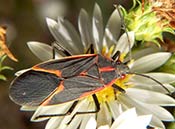 Box Elder Bug. Black with distinctive orange or red markings and wings that overlap their backs to form an "X," box elder bugs are 1/2 inch long. Outdoor insects that feed primarily on box elder trees, these insects will also feed on maple and ash trees or low vegetation, but pose no threat to plants or trees. Their tiny bright red nymphs can sometimes be seen swarming on tree branches or leaves where they lay their eggs.
Box Elder Bug. Black with distinctive orange or red markings and wings that overlap their backs to form an "X," box elder bugs are 1/2 inch long. Outdoor insects that feed primarily on box elder trees, these insects will also feed on maple and ash trees or low vegetation, but pose no threat to plants or trees. Their tiny bright red nymphs can sometimes be seen swarming on tree branches or leaves where they lay their eggs.
While harmless, box elder bugs can become a problem pest in fall when they can migrate indoors in large numbers searching for winter habitat. In large numbers these insects can stain walls and curtains with their excrement. Box elder bugs prefer warm areas and are attracted to buildings with southern or western exposures. Indoors, look for these insects near sunny windows.
 Centipedes and Millipedes. Segmented insects, centipedes and millipedes are usually found outdoors but may seek harborage in damp basements or under sinks in dry weather. Both have segmented bodies and appear to move in a rippling snake-like motion.
Centipedes and Millipedes. Segmented insects, centipedes and millipedes are usually found outdoors but may seek harborage in damp basements or under sinks in dry weather. Both have segmented bodies and appear to move in a rippling snake-like motion.
Centipedes have long, thin legs that protrude along the length of their segmented bodies. Generally brown to red, subterranean species lack pigmentation and have a whitish appearance.
In New Jersey, centipedes range in size from about 1 inch to as much as a foot and live outdoors in soil, leaf litter, deadwood and under stones. Nocturnal hunters, centipedes are carnivores, feeding on soft-bodied insects, spiders and worms. Considered harmless to humans, centipedes do have a venomous bite that can cause allergic reactions.
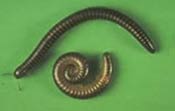 Millipedes are dark reddish brown with thin, cylindrical, worm-like bodies about 1 1/2 inches long with two pairs of short, tiny legs per segment. When touched, they curl into a corkscrew.
Millipedes are dark reddish brown with thin, cylindrical, worm-like bodies about 1 1/2 inches long with two pairs of short, tiny legs per segment. When touched, they curl into a corkscrew.
Most active at night, millipedes feed on the decaying organic matter in which they live, including mulch, compost piles and grass clippings. In dry weather, millipedes may move indoors seeking moisture. While not poisonous, millipedes do discharge fluids that can irritate human skin.
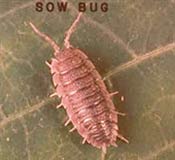 Pillbug and Sowbug. Also called wood lice, pillbugs and sowbugs are not actually insects but crustaceans like shrimp and crayfish. Gray or brown in color and from 1/2 to 3/4 inch long, they have seven pairs of legs attached to flat, oval, wingless bodies with overlapping armored plates that make them look like miniature armadillos.
Pillbug and Sowbug. Also called wood lice, pillbugs and sowbugs are not actually insects but crustaceans like shrimp and crayfish. Gray or brown in color and from 1/2 to 3/4 inch long, they have seven pairs of legs attached to flat, oval, wingless bodies with overlapping armored plates that make them look like miniature armadillos.
When disturbed, pillbugs curl up into a protective ball, but sowbugs do not. Nocturnal, both of these pests feed on decaying organic matter, particularly garden mulch, and live in damp outdoor environments such as under stones and logs and in mulch and compost.
Pillbugs and sowbugs occasionally wander indoors seeking moisture and may be noticed in basements, laundries or bathrooms.
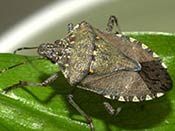 Stink Bug. About 3/4 inch long
with distinctive shield-shaped bodies nearly as wide as they are long, stink
bugs are also called shield bugs. Usually dull brown or gray with two pairs
of wings that overlap their backs in the shape of an "X," stink bugs
use color as camouflage and may be green, blue or black with red markings.
Stink Bug. About 3/4 inch long
with distinctive shield-shaped bodies nearly as wide as they are long, stink
bugs are also called shield bugs. Usually dull brown or gray with two pairs
of wings that overlap their backs in the shape of an "X," stink bugs
use color as camouflage and may be green, blue or black with red markings.
Stink bugs are named for the foul-smelling liquid they secrete in defense. True insects, stink bugs have sucking mouthparts and feed on plant juices or the body fluids of other insects, depending on species, of which there are thousands. Insect-feeding stink bugs are beneficial, but plant feeders are a serious agricultural pest and can damage garden plants. Attracted to the warm outside walls of buildings, stink bugs overwinter indoors in wall voids, reemerging in spring. On sunny winter days, they may be observed on indoor walls.
 Thrips. A brown to black, slender, cigar-shaped
insect just 1/25 inch long, thrips have fringed wings. Also called wood lice,
thunderflies and thunder bugs, thrips feed on plants or other insects, using
their sucking mouthparts to suck out the juices. Depending on their food source,
thrips can be either beneficial or a significant agricultural and garden pest.
Thrips. A brown to black, slender, cigar-shaped
insect just 1/25 inch long, thrips have fringed wings. Also called wood lice,
thunderflies and thunder bugs, thrips feed on plants or other insects, using
their sucking mouthparts to suck out the juices. Depending on their food source,
thrips can be either beneficial or a significant agricultural and garden pest.
While not adept fliers, thrips are easily carrier on the wind and exploding populations can swarm gardens or fields. Thrips larvae may bite humans while they are gardening, causing a prickly sensation and slight itching but no redness or swelling.
Particularly near fields and shaggy lawns where these insects harbor among folded grass and plant leaves, thrips may invade homes, their minute size allowing them to penetrate window screens.
Thrips can be an unsightly indoor nuisance when they crawl behind the glass of framed picture seeking shelter.










